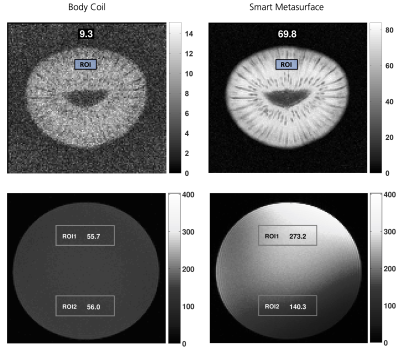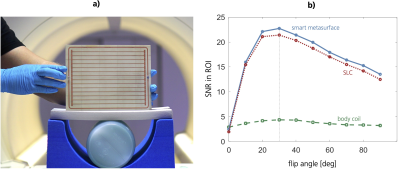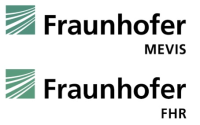Dennis Philipp1, Endri Stoja2, Simon Konstandin1, Robin Wilke1, Diego Betancourt2, Thomas Bertuch2, Juergen Jenne1,3, Reiner Umathum1,3, and Matthias Guenther1,4
1Fraunhofer MEVIS, Bremen, Germany, 2Fraunhofer FHR, Wachtberg, Germany, 3German Cancer Research Center DKFZ, Heidelberg, Germany, 4MR Imaging and Spectroscopy, Faculty 01, University of Bremen, Bremen, Germany
1Fraunhofer MEVIS, Bremen, Germany, 2Fraunhofer FHR, Wachtberg, Germany, 3German Cancer Research Center DKFZ, Heidelberg, Germany, 4MR Imaging and Spectroscopy, Faculty 01, University of Bremen, Bremen, Germany
A thin and smart metasurface shows an eightfold enhanced SNR in 3T MRI. Patient safety is assured by self-detuning in Tx without any need for manual control. On-bench measurements and MRI phantom scans prove the functionality and working principle.

Figure 2. Exemplary MRI results for homogeneous phantom images (bottom) and kiwi fruit images (top) without / with the smart metasurface. The SNR in the indicated ROI is given in the subplots, respectively. For the homogeneous phantom images (TR = 100 ms), the imaged slices are orthogonal to the metasurface while for the kiwi fruit images (TR = 1 s) the slices are parallel to the surface.

Figure 1. a) The manufactured smart metasurface prototype. b) MRI results for scans with different nominal flip angles. The SNR in the ROI for the kiwi fruit scans, see Fig. 2, is shown for imaging with the body coil, the body coil in combination with the smart metasurface, and a local single loop coil (SLC). For these scans, TR = 100 ms was used.
